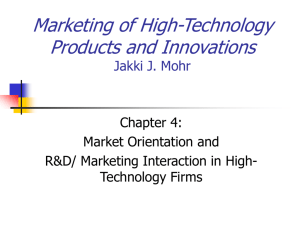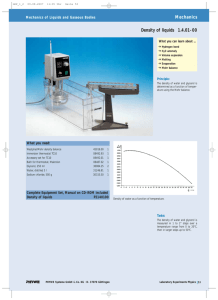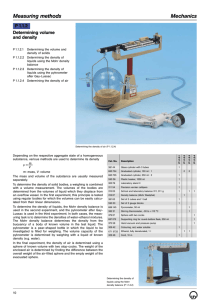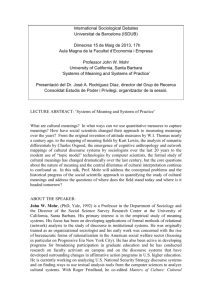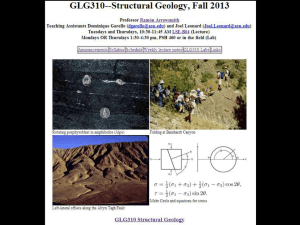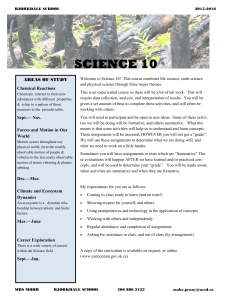Marketing of High-Technology Products and Innovations Jakki J. Mohr
advertisement
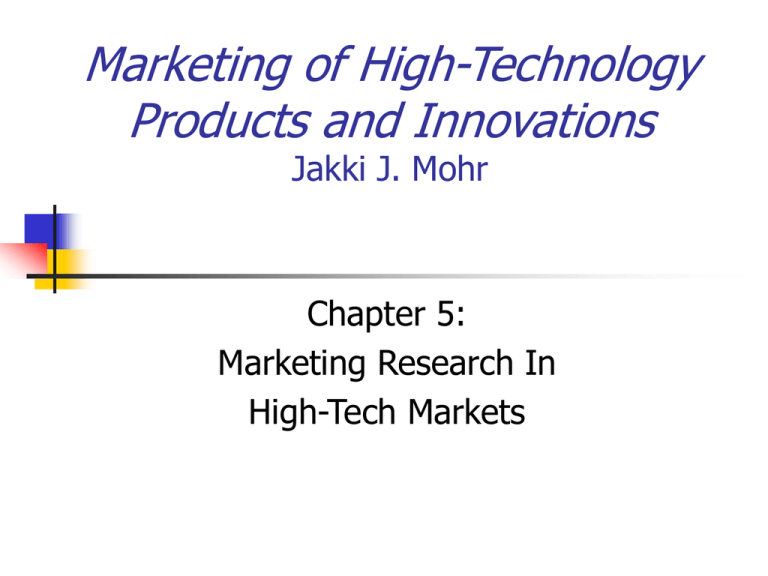
Marketing of High-Technology Products and Innovations Jakki J. Mohr Chapter 5: Marketing Research In High-Tech Markets Outline of Chapter : Gathering Information in High-Tech Markets High-Tech Marketing Research Tools Empathic Design Lead Users Quality Function Deployment Gathering Competitive Intelligence Forecasting Demand Delphi method Analogous Products Information Acceleration Jakki Mohr © 2000 High-Tech Marketing Research Align marketing research tools with type of innovation Incremental innovation: Breakthrough products: Rely on traditional marketing research tools— Focus groups, surveys, conjoint analysis, etc. Market intuition, future scenarios Mid-range Empathic design, lead users Jakki Mohr © 2000 Aligning Market Research with the Type of Innovation Traditional Market Research Market Intuition Empathic Design Lead Users Break-through innovation (technical solution precedes customer need, "technology push") Incremental Innovation (need known) Jakki Mohr © 2000 Empathic Design Because users may be unable to articulate their needs, this technique focuses on observations of customer behavior to develop a deep understanding the user’s environment. Types of insights Triggers of Use Unarticulated user needs/coping strategies New useage situations Customization Intangible Attributes Jakki Mohr © 2000 5 Steps in Empathic Design 1. Observation Who should be observed? Who should do the observing? What behavior should be observed? 2. Capture the Data Less focus on words/text; more on visual, auditory, and other sensory cues Via photos, etc. Jakki Mohr © 2000 5 Steps in Empathic Design (Cont.) 3. Reflection and Analysis 4. Brainstorm for Solutions Identify all customers’ possible problems and solutions Transform observations into ideas 5. Develop prototypes of solutions Tangible representation or role play/simulation of ideas Jakki Mohr © 2000 Use of Empathic Design At Intel Success rate based on engineers’ idea only 20% Example: video phone Team of 8 design ethnographers to find how technology can help solve user problems Salmon industry Business owners Teenagers Jakki Mohr © 2000 Customer Visits Use cross-functional teams Engineering, marketing, sales account manager Supportive corporate culture Visit different kinds of customers: Competitor’s customers, lost customers, lead users, channel intermediaries, internal personnel Customer councils Jakki Mohr © 2000 Customer Visits (Cont.) Go to the customer’s site (versus bringing them on-premise for a “dog and pony” show) Ask probing questions Ensure customer visits are programmatic/systematic (not ad hoc) Jakki Mohr © 2000 Lead Users Some customers face needs before a majority of the market place; Their needs may be more extreme than typical customers Ex: auto racers’ and military’s needs for better brakes They stand to benefit by obtaining solutions to their needs sooner rather than later They tend to innovate their own solutions to their needs (see Table 5-1) Jakki Mohr © 2000 Lead Users Time NUMBER OF USERS WITH NEED FOR NOVEL PRODUCT "LEAD USERS" of later commercialized modifications and enhancements "LEAD USERS" of novel products Some Users Begin To Experience/ Respond To Need First Responsive Commercial Product Introduced Jakki Mohr © 2000 Market Growth Lead Users in Market Research The lead user process can create breakthrough products by systematically identifying lead users and learning from them. Jakki Mohr © 2000 Steps in Lead User Research 1. Identify important trend Via standard environmental scanning 3M identified trend of detecting small features via medical imaging, which required higher-quality high-resolution images Jakki Mohr © 2000 Steps in Lead User Research 2. Identify and question lead users Personal contacts with customers, surveys, networking with experts, empathic design Respect possible sensitivity of information Ex: 3M identified radiologists working on most challenging medical problems, who had developed imaging innovations to meet their needs Networking to other fields in pattern recognition (the military) and semiconductors Jakki Mohr © 2000 Steps in Lead User Research 3. Develop the breakthrough product(s) Host a workshop for experts and lead users to brainstorm Ex: medical imaging, experts in high-resolution imaging, and pattern recognition developed ideas 4. Assess how well lead user data and experiences apply to more typical users Gather market research from typical users Jakki Mohr © 2000 Benefits of the Lead User Process New insights from gathering and using information in new ways Cross-functional in nature Collaboration with innovative customers Requires corporate support, skilled teams, time. Jakki Mohr © 2000 Example of Lead User Process: 3M Corporation and Infection Control 1. Identify important trends in infection control Travel to extreme situation: surgical environments in developing countries 2. Identify lead users Veterinary hospitals, make-up artists in Hollywood Jakki Mohr © 2000 Example of Lead User Process: 3M Corporation and Infection Control Develop the breakthrough ideas at a workshop with experts and lead users Economy line of surgical drapes, hand-held devices to apply anti-microbial substances to skin, “armor” line to coat catheters and tubes with anti-microbial protection, and upstream containment of infection prior to surgery for high-risk patients. Jakki Mohr © 2000 Quality Function Deployment What: A tool that provides a bridge between the voice of the customer and product design Purpose: Ensure tight correlation between customer needs and product specifications. Requirement: Close collaboration between marketing, engineers, and customers Jakki Mohr © 2000 QFD Process Collect the “voice of the customer” Identify customer needs regarding desired product benefits via customer visits or empathic design Weight or prioritize desired benefits/attributes Collect customer perceptions of competitive products Transform data into design requirements: “Customer requirements deployment:” identify product attributes that will meet customer needs “House of quality:” a planning approach that links customer requirements, design parameters and Jakki Mohr competitive data. © 2000 QFD—Using the Kano Concept Satisfaction One-dimensional Attractive Dysfunctional Functional Must-be Know vs. Unknown Spoken vs. Unspoken Dissatisfaction Jakki Mohr © 2000 QFD—3 Types of Attributes 1. “One-dimensional quality”: Increases in level of attribute linearly related to customer satisfaction Typically “known” attributes identified by customer EX: battery life in lap tops Jakki Mohr © 2000 QFD—3 Types of Attributes (Cont.) 2. “Must-be quality”: Increases in level of attribute has negligible effect on customer satisfaction; However, decreases in attribute has strong negative effect on customer satisfaction Because they are so basic to product functionality, they are typically unspoken attributes: customer expects product to deliver these EX: ability of laptop to handle bumps and rough handling Jakki Mohr © 2000 QFD—3 Types of Attributes (Cont.) “Attractive Quality:” Increases in level of attribute associated with exponential increase in customer satisfaction But, because attribute is one that “delights” the customer, its absence does not necessarily lead to dissatisfaction Typically unknown to customer at conscious level Ex: decompressable/expandable laptop Jakki Mohr © 2000 QFD: Summary Firmly grounds product design in customer needs Allows product development team to develop common understanding of design issues and trade-offs Reveals friction points and enhances collaboration Jakki Mohr © 2000 QFD and Total Quality Management TQM grounded in customer knowledge and ability to deliver customer value, which is enhanced by: Customer excellence Cycle-time excellence Cost excellence Cultural excellence Jakki Mohr © 2000 Customer excellence Tied to being customer-focused and market-oriented Knowledge of customer environment and product useage Jakki Mohr © 2000 Cycle-time excellence Products late to the market suffer negative impacts to profitability from two reasons: Long time-to-market cycles typically experience cost overruns More importantly, products late to the market suffer loss of market share Lesson: Being fast to market is important, but only when combined with ability to accurately deliver customer requirements Therefore, link QFD with TQM Jakki Mohr © 2000 Relationship between Entries in the Market and Quality Attractive Quality Model 3 ONE-DIMENSIONAL QUALITY Model 2 Model 1 Development Overall Revenue Incr. Revenue New Models Must be quality Time Jakki Mohr © 2000 Does this approach to cycle time excellence make sense? Bring higher levels of product functionality to the market incrementally over time with successive product iterations. Yes! Striving for complicated set of features with initial offering can lead to delays Delays mean that customer needs may have changed or a competitor beats firm to the market Purchasers of first generation of new product become installed base for later generations Jakki Mohr © 2000 QFD and TQM (Cont.) Cost Excellence Provide customer value and lowest possible cost Use supply partnerships Use downsizing cautiously, lest negative impact on customer value Cultural Excellence: Align goals of the organization and of personnel to be able to capitalize on market opportunities Ex: culture of innovation, effective marketing/R&D interaction Jakki Mohr © 2000 Competitive Intelligence What: Information about competitors Why: Provides information for better decision making and improved strategies An early warning system Jakki Mohr © 2000 Effective Competitive Intelligence Programs Affect decisions of top managers Are proactive in reading the market Look beyond existing market boundaries Utilize the Web Gauge potential for misleading signals Jakki Mohr © 2000 Forecasting Customer Demand for High-Tech Innovations “Who the hell wants to hear actors talk?” Harry M. Warner (1927) reacting to addition of audio technology to silent movies “ “Television won’t be able to hold on to any market it captures after the first six months. People will soon get tired of staring at a plywood box every night.” Darryl Zanuck, 20th Century Fox Films, 1946 “There is little reason for any individual to have a computer in their home.” Ken Olsen, president andJakki founder of the DEC Mohr © 2000 Corporation,1977 Qualitative Forecasting Tools Delphi method Analogous data Rely on a panel of experts Rely on similar products Information Acceleration Use “virtual” prototypes to obtain customer feedback Jakki Mohr © 2000 High-Tech Forecasting Hazards Lack of historical data Difficult for customers to articulate preferences Inflated projects from over-enthusiasm Competition from incumbent technologies Don’t confuse confidence in the forecast with quality of the information Jakki Mohr © 2000
